
Trillium erectum, the red trillium, also known as wake robin, purple trillium, bethroot, or stinking benjamin, is a species of flowering plant in the family Melanthiaceae. The plant takes its common name "wake robin" by analogy with the European robin, which has a red breast heralding spring. Likewise Trillium erectum is a spring ephemeral plant whose life-cycle is synchronized with that of the forests in which it lives. It is native to the eastern United States and eastern Canada from northern Georgia to Quebec and New Brunswick.

Verbascum is a genus of over 450 species of flowering plants, common name mullein, in the figwort family Scrophulariaceae. They are native to Europe and Asia, with the highest species diversity in the Mediterranean.

Anemonoides nemorosa, the wood anemone, is an early-spring flowering plant in the buttercup family Ranunculaceae, native to Europe. Other common names include windflower, European thimbleweed, and smell fox, an allusion to the musky smell of the leaves. It is a perennial herbaceous plant growing 5–15 cm (2–6 in) tall.
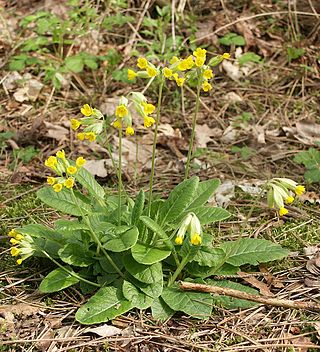
Primula veris, the cowslip, common cowslip, or cowslip primrose, is a herbaceous perennial flowering plant in the primrose family Primulaceae. The species is native throughout most of temperate Europe and western Asia, and although absent from more northerly areas including much of northwest Scotland, it reappears in northernmost Sutherland and Orkney and in Scandinavia. This species frequently hybridizes with other Primulas such as the common primrose Primula vulgaris to form false oxlip which is often confused with true oxlip, a much rarer plant.

Verbascum thapsus, the great mullein, greater mullein or common mullein, is a species of mullein native to Europe, northern Africa, and Asia, and introduced in the Americas and Australia.

Actaea spicata, the baneberry or herb Christopher, is a species of flowering plant in the genus Actaea, native from Europe to western Siberia and northern Iran. It is often found on limestone edges and in deciduous woodland; key factors are shade, low competition, and a cool, protected root run.

Ornithogalum umbellatum, the garden star-of-Bethlehem, grass lily, nap-at-noon, or eleven-o'clock lady, a species of the genus Ornithogalum, is a perennial bulbous flowering plant in the asparagus family (Asparagaceae). O. umbellatum is a relatively short plant, occurring in tufts of basal linear leaves, producing conspicuous white flowers, in a stellate pattern, in mid to late spring. The flowers open late in the day, but when closed have a green stripe on the outside. It is native throughout most of southern and central Europe, and north-western Africa. O. umbellatum is often grown as a garden ornamental, but in North America and other areas it has escaped cultivation and can be found in many areas, where it may become an invasive noxious weed. Parts of the plant are considered poisonous, but are used in some regional cuisines. Essences are also sold as patent remedies. O. umbellatum has been depicted in art by artists such as Leonardo da Vinci, and folklore has suggested it originally grew from fragments of the star of Bethlehem, hence its horticultural name.

The mullein moth is a noctuid moth with a Palearctic distribution. The species was first described by Carl Linnaeus in his landmark 1758 10th edition of Systema Naturae.

Verbascum blattaria, the moth mullein, is a flowering biennial plant belonging to the figwort family Scrophulariaceae. A native of Eurasia and North Africa, it has naturalized in the United States and most of Canada since its introduction and has become an invasive species there. It has been declared a noxious weed by the state of Colorado.

Verbascum nigrum, the black mullein or dark mullein, is a species of biennial or short-lived perennial herbaceous plant in the mullein genus Verbascum, native to dry open sites in temperate Europe. It grows to 0.5–1.5 m (1.6–4.9 ft).

Digitalis thapsi, which has been called mullein foxglove in the US, is a flowering plant in the genus Digitalis that is endemic to the Iberian Peninsula, where it occurs in eastern Portugal and central and western Spain. It is of commercial importance as an ornamental plant. Hybrids with D. purpurea have proved successful and are fertile.

Verbascum phoeniceum, known as purple mullein, is a species of mullein that is part of the family Scrophulariaceae native to Central Europe, Central Asia and Western China. It is also naturalized in certain regions of the US and Canada. It successfully grows in USDA’s zones 4 to 8. It is a short-lived perennial species, and blooms earlier than other mullein species on average, producing vibrant purple-pink flowers; it can grow up to 1m or more.
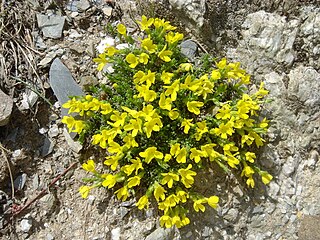
Androsace vitaliana is a species of plant in the primrose family, Primulaceae. It was previously known by the synonym Vitaliana primuliflora. Native to the high mountains of Europe, it is cultivated as an alpine garden plant, being considered easy to grow in well drained soil in a sunny position.
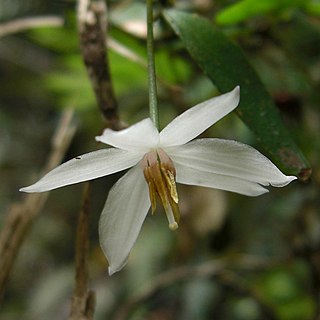
Luzuriaga radicans is a species of flowering plant in the genus Luzuriaga of the family Alstroemeriaceae (Inca-lilies), part of the monocot order Liliales. It is native to Chile and Argentina.

Verbascum sinuatum, commonly known as the scallop-leaved mullein, the wavyleaf mullein, or Candela regia, is a species of perennial herbaceous plants in the genus Verbascum (mullein), growing in heavy soils in Central Asia and the Mediterranean region. It grows to 1.2–1.5 m (3.9–4.9 ft). The plant has an erect inflorescence stem, and is entirely covered with stellate hairs (trichomes) which are not pleasant to the touch.
Eriocapitella rupicola, a species of flowering plant in the buttercup family Ranunculaceae, is native to Asia. The specific epithet rupicola means "growing on rocks". In Chinese, a common name is yan sheng yin lian hua, which means "rock anemone".
Lysimachia × producta is a hybrid of flowering plants in the primrose family Primulaceae. It is native to eastern North America, from Quebec south to North Carolina, as far west as Wisconsin. The hybrid specific epithet producta means "stretched out, extended", a reference to the shape of its inflorescence. Indeed, the hybrid is sometimes referred to as the elongated loosestrife.
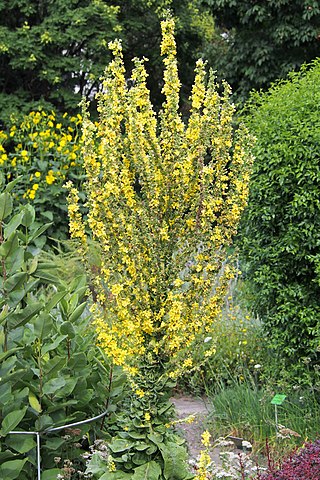
Verbascum olympicum, the Greek mullein, Olympian mullein or Olympic mullein, is a species of flowering plant in the family Scrophulariaceae, native to northwest Turkey. A short-lived perennial reaching 2 m, the Royal Horticultural Society considers it a good plant to attract pollinators.
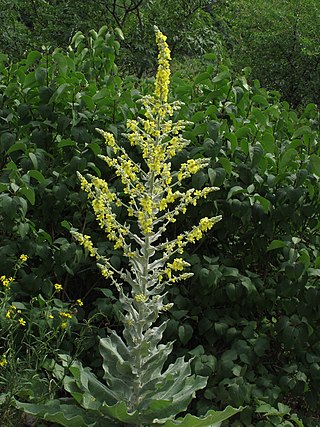
Verbascum pulverulentum, the hoary mullein or broad-leaf mullein, is a species of flowering plant in the family Scrophulariaceae. It is native to central and southern Europe, and has been introduced to Austria, Madeira, and Washington state in the US. It is a specialist on coastal shingle, and so is preadapted to human-influenced habitats such as old quarries and gravel pits, road verges, railway embankments, and similar disturbed stony ground.

Verbascum boerhavii, the annual mullein, is a species of flowering plant in the family Scrophulariaceae, native to Spain, France, and Italy. It has been traditionally used as a treatment for haemorrhoids. It contains the phenylpropanoid glycoside poliumoside, which has an affinity for metalloproteinases.



















